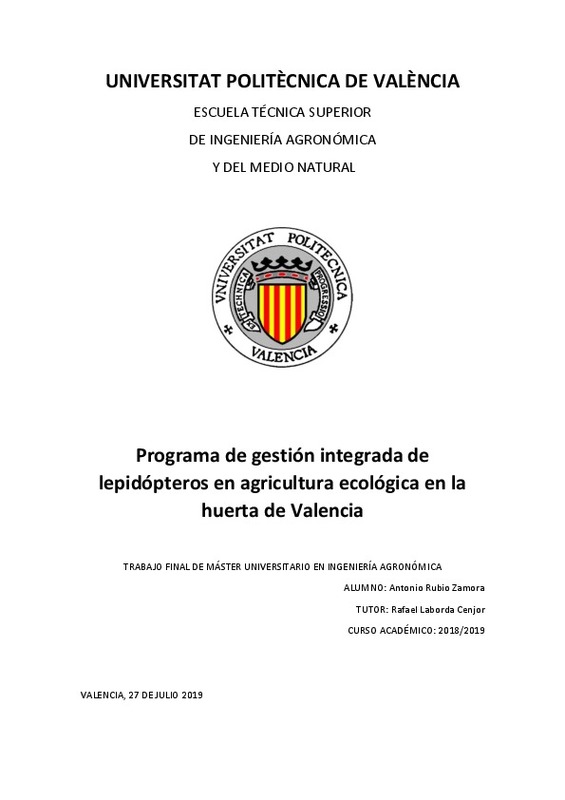|
Resumen:
|
[ES] El presente trabajo de fin de master busca establecer un manejo integrado de plagas, específicamente de lepidópteros, para la empresa SAIFRESC situada en Manises, con el objetivo de optimizar la gestión de productos ...[+]
[ES] El presente trabajo de fin de master busca establecer un manejo integrado de plagas, específicamente de lepidópteros, para la empresa SAIFRESC situada en Manises, con el objetivo de optimizar la gestión de productos fitosanitarios y la reducción de tiempos de trabajo. Los cultivos sobre los que se realizará el trabajo serán hortícolas tales como distintos tipos de coles, boniato y patata.
Se realizarán varios protocolos de muestreo para obtener información de las distintas especies de lepidópteros presentes en campo mediante muestreo visual y recurriendo a dos tipos de trampas distintas (trampa tipo polillero y trampa tipo delta), las dos cebadas con feromonas sexuales. Se realizarán curvas de vuelo de las plagas principales los años anteriores y que ocasionaban más daños como eran Spodoptera littoralis y Spodoptera exigua.
El objetivo de estos muestreos es determinar el momento óptimo de tratamiento con productos fitosanitarios gracias a la obtención de la curva de vuelo, que se relacionarán con el momento de mayor presencia de larvas en los primeros estados larvarios. Además, se buscará que las estrategias de muestreo sean rápidas y sencillas para que sean fácilmente replicadas por el agricultor o trabajadores de las parcelas.
Se realizará un ensayo en laboratorio con Bacillus thuringiensis ya que está autorizado en agricultura ecológica. Para este ensayo se realizará una cría del lepidóptero Spodoptera littoralis obteniéndose un considerable número de larvas para cada estado larvario y posteriormente se aplicará Bacillus thuringiensis a cada uno de estos estados larvarios para evaluar su eficacia. Con esto se busca conocer el momento óptimo de aplicación para reducir así la cantidad de productos que se aplican y a la vez reducir las dosis de aplicación.
Por último, se busca diseñar una estrategia de actuación de acuerdo con los responsables de la finca para la temporada siguiente para evitar daños graves por lepidópteros como otros años sí ha sufrido y conseguir la máxima eficacia en el control de estos fitófagos.
[-]
[EN] This end-of-Master's Project seeks to establish an integrated pest management, specifically of Lepidoptera, for the SAIFRESC company situated in Manises, with the aim of optimising the management of plant protection ...[+]
[EN] This end-of-Master's Project seeks to establish an integrated pest management, specifically of Lepidoptera, for the SAIFRESC company situated in Manises, with the aim of optimising the management of plant protection products and the reduction of working times. Crops on which it will do the job will be vegetables such as different types of cabbage, sweet potato and potato.
Several sampling protocols will be made for information of the different species of Lepidoptera in field by using visual sampling, using two types of different traps (funnel trap and delta trap), barley with sex pheromones. There will be made major pests flight curves previous years and which caused more damage were Spodoptera littoralis and Spodoptera exigua.
The objective of these sampling is to determine the optimal treatment timing with plant-protection products thanks to obtain the curve's flight, which will relate to the time of greater presence of larvae in the early larval stages. In addition, will be sought that sampling strategies are fast and easy so that they are easily replicated by the farmer or worker of the plots.
A trial will be made in laboratory with Bacillus thuringiensis as it is authorized in ecological agriculture. This trial will take place a breeding of the Spodoptera littoralis resulting in a considerable number of larvae for each larval stage and then applies Bacillus thuringiensis on each of these larval stages to assess its efficiency. This seeks to know the optimum time of application to reduce the amount of products that are applied and at the same time reduce application rates.
Finally, it seeks to design an action strategy in accordance with responsible for property for the next season to avoid serious damage by Lepidoptera such as other years has suffered and achieve maximum efficiency in the control of this pest.
[-]
|






